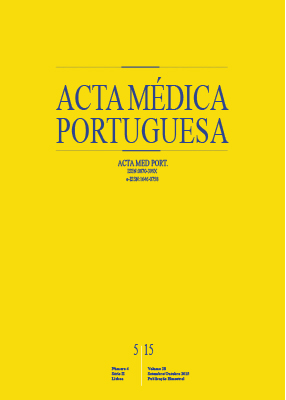Takotsubo Cardiomyopathy: Cause of a Cardiogenic Shock
DOI:
https://doi.org/10.20344/amp.6592Keywords:
Shock, Cardiogenic, Takotsubo Cardiomyopathy.Abstract
Takotsubo cardiomyopathy, of unknown etiology, is characterized by sudden and transient systolic dysfunction of the mid-apical segments of the left ventricle without significant coronary disease, and full normalization of segmental changes. More common in middle-aged women, it is cause of differential diagnosis with acute coronary syndrome. We present the case of a 59 year old woman admitted to the emergency room with sudden chest pain and dyspnea. At presentation: acute hypotensive pulmonary edema requiring aminergic support and invasive ventilation. Blood tests showed elevated necrosis myocardial enzymes. Serial electrocardiograms: sinus rhythm with progressive inversion of the T wave through the precordial leads (v2 - v6). Control echocardiograms: overall decreasedsystolic function with apical akinesia, and full reversal of the changes in 2 weeks. Cardiogenic shock of unknown etiology was admitted and a coronary computed tomography angiography was performed excluding coronary heart disease, supporting the diagnosis of Takotsubo cardiomyopathy.
Downloads
Downloads
Published
How to Cite
Issue
Section
License
All the articles published in the AMP are open access and comply with the requirements of funding agencies or academic institutions. The AMP is governed by the terms of the Creative Commons ‘Attribution – Non-Commercial Use - (CC-BY-NC)’ license, regarding the use by third parties.
It is the author’s responsibility to obtain approval for the reproduction of figures, tables, etc. from other publications.
Upon acceptance of an article for publication, the authors will be asked to complete the ICMJE “Copyright Liability and Copyright Sharing Statement “(http://www.actamedicaportuguesa.com/info/AMP-NormasPublicacao.pdf) and the “Declaration of Potential Conflicts of Interest” (http:// www.icmje.org/conflicts-of-interest). An e-mail will be sent to the corresponding author to acknowledge receipt of the manuscript.
After publication, the authors are authorised to make their articles available in repositories of their institutions of origin, as long as they always mention where they were published and according to the Creative Commons license.









